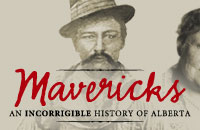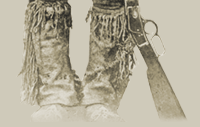 |

[ Project Plans | Essential
Questions | Knowledge Hunt | Glossary | Links ]
"Free Farms for the Million!"
Investigating the West's History by Exploring and Creating
Canadian Advertising for Immigrants
Introduction
Students need to understand how what is now Alberta was very different
in the late nineteenth century. The Canadian West had a very sparse
population and therefore advertising was used by the Canadian Government
to lure immigrants to settle in Western Canada. How did they advertise?
How did they make immigrants want to come to the western provinces?
Where did they advertise? Was the advertising accurate and factual?
Project Explanation
In this project, students will develop an appreciation of Alberta's
geographic, cultural, economic and historical characteristics and
how they have changed since the late nineteenth century. Students
will research advertising practices of the time and examine actual
artifacts and documents that were used to advertise Western Canada
to other countries. They will create their own historical poster
that reflects the methods, language, print styles and formats that
were used to promote Alberta to the citizens of another specific
country.
Alberta Social Studies Curriculum Unit Connections
Grade Four - Alberta: The Land, Histories and Stories
4.2 The Stories, Histories and People of Alberta
4.3 Alberta: Celebrations and Challenges
Grade Five - Canada: The Land, Histories and Stories
5.1 Physical Geography of Canada
5.2 Histories and Stories of Ways of Life in Canada
Grade Seven - Canada: Origins, Histories and Movement of People
7.2 Following Confederation: Canadian Expansions
Materials and Resources Needed
Procedures
Students will create an authentic, historical poster or pamphlet
promoting the Canadian West to potential settlers from another country.
Students will begin by researching why the Canadian Government
would need and want to advertise to lure immigrants to Western Canada.
Using the "Last Best West" and poster sites in the resources
sections, they will determine the reasoning for the ads, their audience,
the message they tried to get across, and some of the techniques
used to have people leave their country to come to Canada. Using
the Mavericks: An Incorrigible History of Alberta Newcomers
and Ranching content areas, they will look for the enticements to
the Alberta way of life that could be used to attract people from
other countries.
As a group, have students come together to identify the crucial
elements that would be needed for the historical posters or pamphlet
they will be creating. These should include a slogan or title, crucial
information and details, the person or group they should contact,
who created the poster (Canadian Government, CPR, Allan Steamship
Line, etc.), vivid artwork, and a persuasive writing paragraph explaining
why they should come to Western Canada.
The students, either individually or in groups, will create their
own historical poster or pamphlet that reflects the advertising
methods, style of language and print, and artistic impression that
were used to promote Alberta. They will choose a specific country's
citizenry to act as their audience. It must be persuasive and market
settling in Western Canadian to others.
Another option is to have each student or group research and create
their posters from the unique perspective of one specific group.
Possibilities could include the Federal Government, the Canadian
Pacific Railway, the Allan Steamship Line, the First Nations (Tom
Three Persons), the big ranchers (George Lane), settlers who were
already here, American immigrants or ex-slaves (John Ware). For
example, the big ranchers did not want settlers coming to the west,
as it would begin to divide the land and force an end to the open
range. Would their poster promote immigrants to come to settle the
west or attempt to deter them? What message might it attempt to
get across?
The media used by students may be specified by the teacher or left
to choice. Options could include pencil crayon, felt, a drawing
program on a computer, a collage using photos of Alberta and its
characteristics, or any other media available. Photographs or artifact
pictures may be printed from either the Mavericks: An Incorrigible
History of Alberta site or the Images Canada site.
Some tips on using the Images Canada web site:
- Choose "advanced search" if you want to combine
terms. For example, type "ranches" in "subject"
(pull down menu) and "food" in "subject".
This will provide 24 photos, whereas typing "ranches food"
as a single search term will return "No Images Found".
- Just the name can be used in a single search. Searching "george
lane" yields 142 photos, "john ware" yields
26 photos, and "tom three persons" yields 17.
- Click on "more information" under each picture to
find other subject terms to use in searching. For example, you
can use "dwelling" or "houses" instead
of "shelter".
- Photos may be copied into another program like Word and then
enlarged or printed in a landscape format if needed.
All images can be reproduced, in print and/or digital format,
for non-commercial, educational purposes. The images must
not be altered or manipulated in any way and proper credit must
accompany the images. See link below for more information.
http://www.imagescanada.ca/r1-230-e.html
As students complete their projects, they can then consider how
the same goals might be accomplished in today's society. Does
the Alberta Government still create advertisements? Who are they
aimed at? Why would they choose to spend money on trying to get
their message across? Was it effective for that audience? How has
advertising in general changed since those first, early posters
promoting the Canadian West?
Assessment and Evaluation
- Students and their teacher should develop their own rubric by
identifying evaluation criteria for the project that will match
their own learner outcomes. This allows students to understand
the expectations for their work and to have input into the ongoing
evaluation process.
- Individually or in small groups, students might evaluate the
work of two or three other students in order to gain insight into
how their peers approached the project.
- After completing the project, students may talk or journal about
what they felt they did very positively, what they had difficulty
with, and how they would change how they would approach a similar
project in the future.
Ideas for Enriching this Project
- Students could explore the idea of migration and how it has
changed in the past 100 years. Where will be the next place we
will be pioneering? What would the advertisements for immigrants
look like then? Will it be Mars? A city under the ocean? A space
station? A planet outside our solar system?
- Using the Media Awareness Network site (http://www.media-awareness.ca/),
conduct a study looking into how various aspects of advertising
affect our viewpoints. There are many excellent and very usable
resources in the "For Teachers" link on media literacy
and web awareness.
- A mathematical survey or data collection could be taken from
each student as to which is the most persuasive poster or pamphlet.
Students could then analyze the data in order to determine the
results.
 |



![]()
